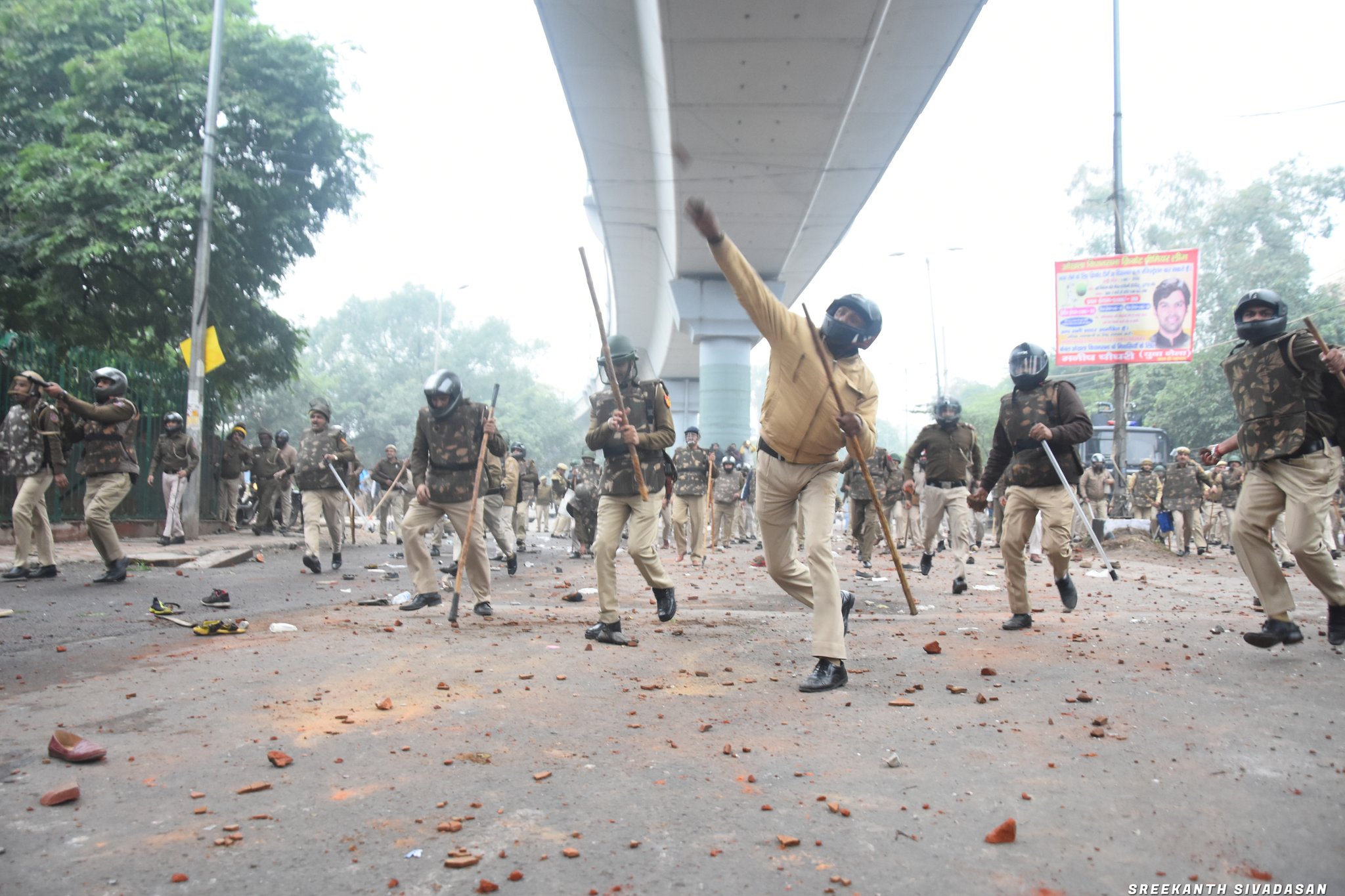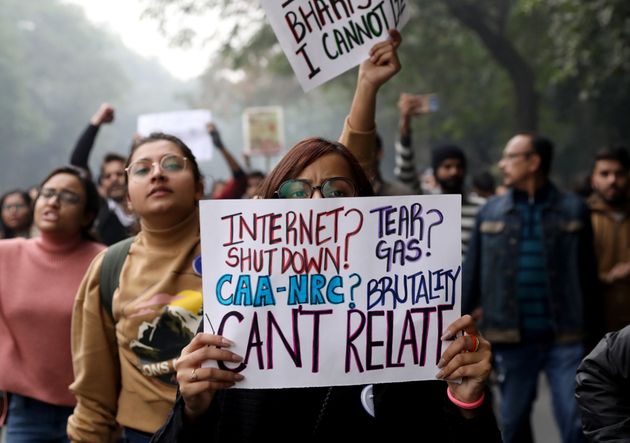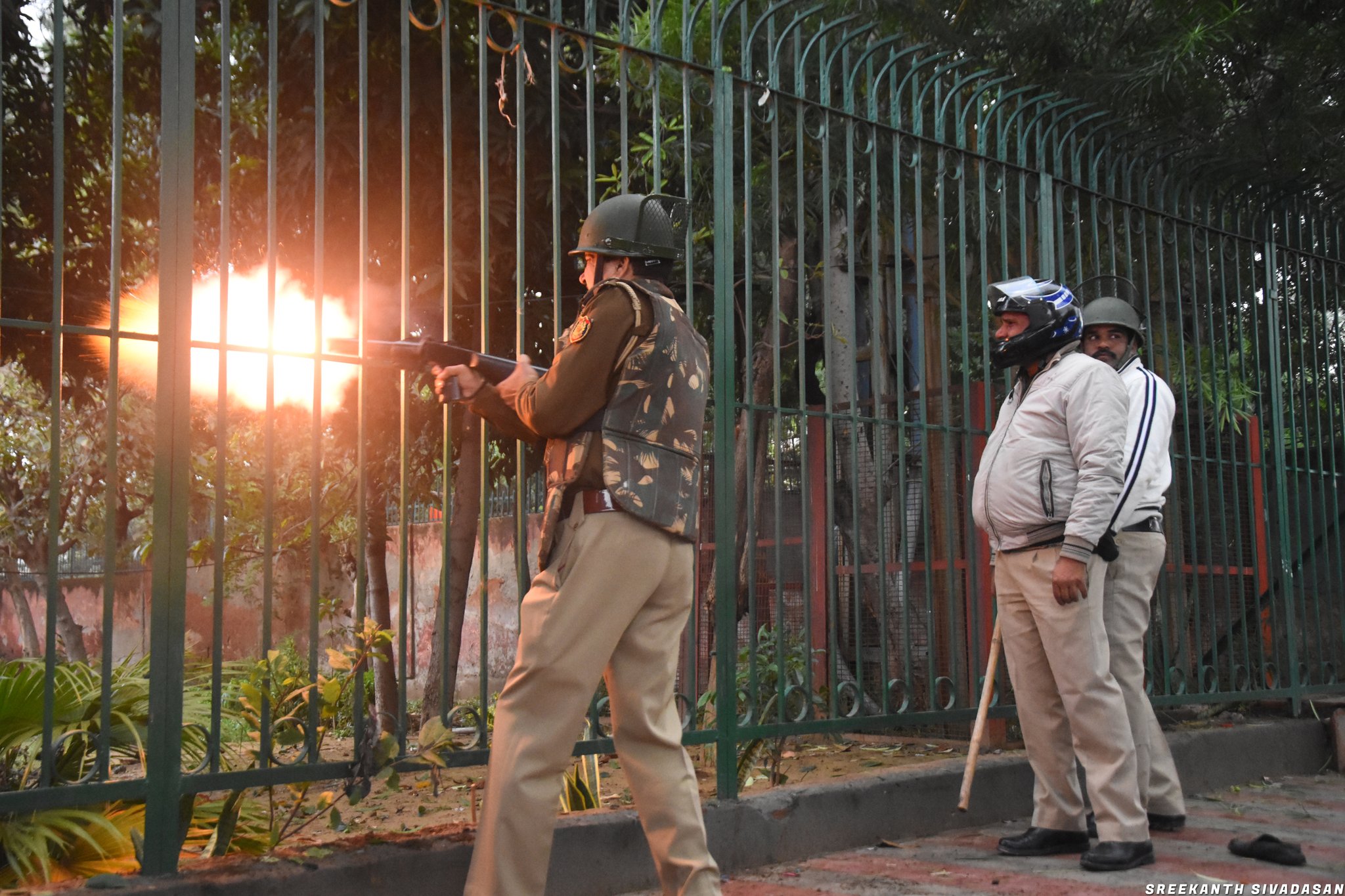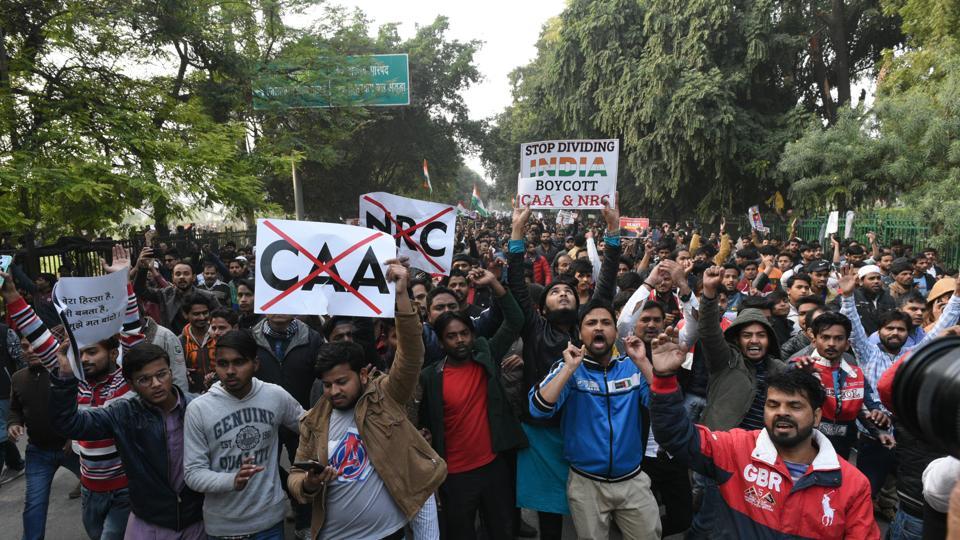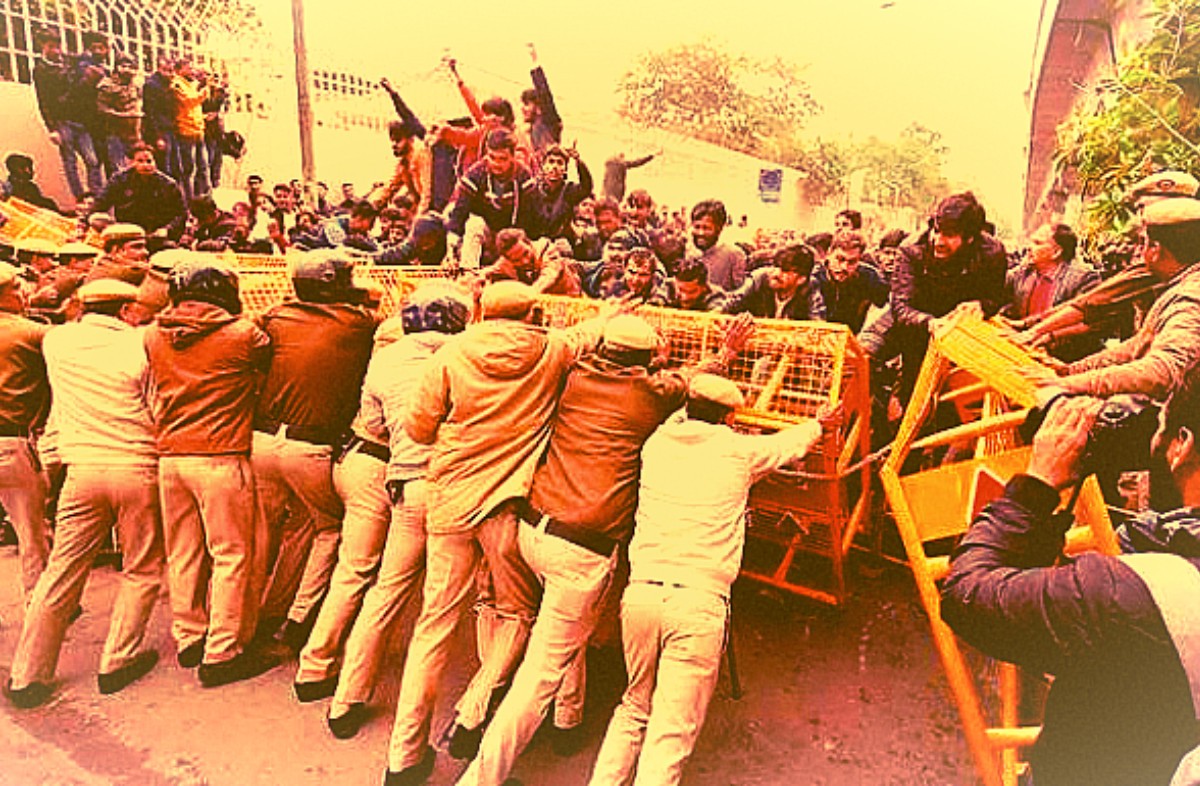Filed under: Critique, Featured, International Coverage
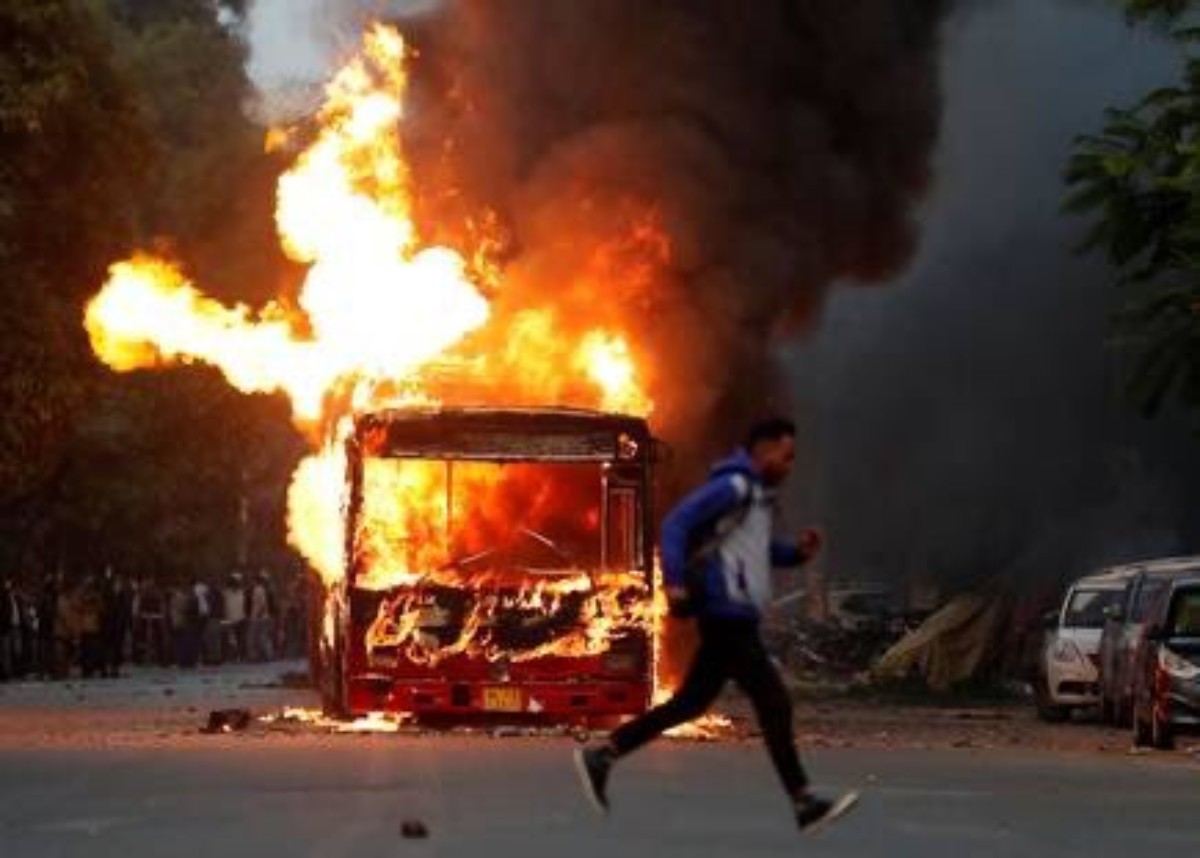
Anticolonial anarchist Sarang Narasimhaiah argues that autonomous anti-capitalists in the US and beyond must stand in solidarity with the growing mass protest movements in India which appose brutal State repression and Hindu nationalism.
“What can I do to make them care?”
This is the question I struggle with as I watch hundreds of thousands of people flood the streets of India’s cities, towns, and villages to protest the heinous Citizenship Amendment Act and National Register of Citizens, among a cavalcade of other inequities, injustices, and cruelties perpetrated by Prime Minister Narendra Modi, the Bharatiya Janata Party (BJP), and their extractivist, Hindu chauvinist governmental apparatus as a whole.
How can I effectively communicate the gravity of the situation back home to my American peers? Moreover, how can I convince them to join the fight against the neoliberal Hindu nationalist state project that threatens to shred India’s social fabric itself, at the same time as it reaffirms and reinforces other authoritarian projects and the overarching neoliberal world order?
I am lucky to have a few cherished Stateside friends, colleagues, and comrades who are at least somewhat cognizant of the dark clouds shrouding India and South Asia right now; more importantly, they are willing to listen, learn, and take whatever solidarious action they can. However, I know that a lot of other South Asians and South Asian Americans residing in North America aren’t quite as lucky. Moreover, I myself have felt despair, confusion, and a not insignificant amount of frustration with many American leftists I have encountered who are entirely ignorant or only superficially aware of the increasingly authoritarian hellscape surrounding more than 1.3 billion people — that is, more than one out of every seven people on Earth. They are also unaware of the intricate, ever-tightening interconnections between India and the American geopolitical sphere. Perhaps most disconcertingly of all, though, quite a few brush off these horrors and their American connections even when they are aware of them.
All Our Struggles are Connected… Sometimes.
What’s most curious about American leftist obliviousness to India’s woes is that it does not map neatly or completely onto an inward-facing nationalist outlook with its inherent, self-serving limitations. Internationalism — verbal, organizational, and material opposition to oppressive systems and support for liberation struggles across the world, most prominently expressed in the form of anti-imperialism — is a key feature of much global leftist politics, be it Marxist-Leninist, Maoist, Trotskyist, anarchist, socialist, communist, or somewhere in-between, including in the United States. In the past year alone, various actors on the American Left have mobilized to oppose the looming prospect of a coup in Venezuela and the disastrously successful coup in Bolivia, America’s betrayal and Turkey’s persecution of the Kurds and other embattled populations in Northern Syria, Israel’s intensified bombardment of the Gaza Strip, and the incineration of the Amazon by agribusiness companies and their proto-fascist Brazilian state backers.
For that matter, the burgeoning climate justice movement exemplified by Greta Thunberg and Extinction Rebellion; the worldwide spread of the Chilean Lastesis feminist collective’s chant, “Un violador en tu camino” (“A rapist in your way”); and the mass uprisings that have erupted everywhere from Hong Kong to France arguably extend well beyond traditional internationalism. Participants across these movements have exchanged and replicated symbols, tactics, and organizational forms to a previously unprecedented degree or, at least, at a previously unprecedented speed. Transnationalism, as opposed to mere internationalism, might thus now be the favored bottom-up response to a world consisting of nation-states and borders that are entangled, subverted, and/or circumvented by the transnational movement of people, capital, and ideas; the globality of crises like climate change; and the proliferation of Internet technology.
And yet, progressive and leftist media outlets and commentators in North America hardly noticed the gargantuan general strike staged by 150 million workers in India in January of 2019. Certain activists, journalists, and intellectuals on the American Left sat up and paid attention when the Modi government abrogated Articles 370 and 35A of the Indian Constitution to consolidate the Indian state’s occupation of Kashmir in August of this year. However, Kashmiris continue to scream, suffer, and die in darkness more than four months on while most supposedly sympathetic American onlookers have moved on to other pursuits. In addition, thousands of diasporic Kashmiris, Indians, and South Asians protested the “Howdy, Modi!” event held to honor the Indian Prime Minister in Houston, Texas on September 22 of this year. Non-South Asian anti-authoritarians and anti-fascists — many of whom have on other occasions robustly protested the visits of Brazil’s Jair Bolsonaro, Turkey’s Recep Tayyip Erdoğan, and other reigning global autocrats — were nowhere to be seen outside the NRG Stadium.
At this point, I sadly cannot envision the majority of Stateside leftists flying the flag of independent Kashmir alongside the flags of Palestine, Rojava, or Plurinational Bolivia. Nor can I see them staging noise demos in solidarity with detainees in the detention camps already up and running in the Northeastern Indian state of Assam, staging die-ins for the victims of rampant police raids, beatings, and killings in Delhi and Uttar Pradesh, or even marching to condemn India’s ever-growing list of sexual assault cases.
But why? What accounts for the American Left’s abject lack of solidarity with India and its most vulnerable populations in their hour of paramount need?
In my view, the American Left largely ignores India’s authoritarian nightmare because it resorts to selective internationalism: North American leftists tend to cherry-pick the countries, movements, organizations, and individuals with whom they express solidarity. This tendency comes down to a range of factors, often working in tandem with each other. Chief among these factors is 1) the American education system’s promotion of imperialist nationalism and arrogance, 2) the mainstream media’s manufacturing of consent, which dovetails with the Hindu Right’s Indian and American propaganda machines; and 3) the Orientalization of India and South Asia, especially through the idolization of M.K. Gandhi and his politics. These factors draw upon and reproduce a strange, contradictory combination of liberal conditioning; imperialist complicity; and leftist nostalgia, exoticism, and demagoguery, which work to preserve crucial aspects of the very neoliberal, imperialist, statist world-system that American leftists claim to oppose.
Teaching Imperialist Nationalism and Arrogance
To begin by stating the obvious, the American education system, particularly at the school level but also beyond it, is profoundly flawed and perhaps broken beyond repair. In accordance with its ever-increasing privatization and class stratification, racialization, and collusion with the policing and military-industrial complexes, the school system is pedagogically circumscribed by the borders, myths, and mandates of the American settler-colony and empire — specifically, by the latter’s rootedness in Christian white supremacist capitalist patriarchy. All too often, schools convert Indigenous genocide, Black slavery, class oppression, xenophobia, and imperialist interventionism— America’s foundational and, in many respects, continuing atrocities — into cathartic liberal guilt trips at best or tiresome hoaxes at worst.
Now, every nation-state’s educational agenda is nationalistic by its very definition and design. However, America’s exceptionalist self-image and its obsession with remaking the world according to this image make its foundational lies particularly potent and encompassing. Whereas most other countries can simply block out the rest of the world to center their own narratives, the United States, as the world’s pre-eminent superpower (pending its displacement by China), has to assert its own global supremacy even when it erases the rest of the world map. This narrative fosters what I would term imperialist nationalism and corresponding imperialist arrogance in the American populace at large across multiple generations (across successive graduating classes, if you will). Schools and, to some extent, colleges and universities tend to encourage Americans to only know enough about the rest of the world to feel reassured that they are and always will be number one.
Even the most well-meaning Americans, up to and including many progressives and leftists from non-white, non-European, non-elite backgrounds, often struggle to extend their understanding of the world beyond American hegemony. They have deep-seated and thus instinctive justifications for the horrors wrought by American Empire, while also having no reason to comprehend, care about, or even acknowledge societies, cultures, and issues at or beyond the boundaries of their imperialist domain. Latin America is where tacos come from, the Middle East is where terrorists come from, China is where cheap electronics come from, and so on: you’ve probably seen all the memes and satirical world maps. India, which typically stands in for South Asia in its entirety, is where poverty, yoga, spicy food, and Bollywood dance numbers come from. Despite having had a noticeable presence in and other connections to the United States and North America since at least the late 1800s, Indians and other South Asians are mostly footnotes in the imperialist nationalist narrative forced upon students.
And that’s the more benign variant of imperialist arrogance. The accelerating erosion of American imperialist power seems to have only made many Americans even more desperate to cling to their ingrained collective delusions about the origins of their country and its role in the world-system. Co-shaped by the white fragility and toxic masculinity sharpened by late capitalist crises within America itself and its Empire at large, this desperation has inspired a rash of vicious nativism and unapologetic fascism. Several leaders and members of far-right organizations like Patriot Prayer and the Proud Boys walk around with t-shirts bearing the slogan, “Pinochet did nothing wrong,” claiming the savage US-backed Chilean dictator’s reign of terror as a notch on their own belts. The groundswell of fascist activity to which these groups belong has been responsible, among other things, for a sharp spike in hate crimes against people of South Asian descent.
The children of American Empire are never innocent. The imperialist arrogance inculcated by their education is a ticking time-bomb, waiting to go off in a mosque, synagogue, Hindu temple, Black church, or migrant neighborhood.
Manufacturing Consent, with a Saffron Twist
Maybe even more so than the education system, mainstream media organizations in the United States are the handmaidens of American Empire. Linguist and anarchist philosopher Noam Chomsky has extensively analyzed how both the liberal and conservative media manufacture consent, censoring themselves and suppressing dissent to reinforce statist, capitalist, and imperialist power for the sake of profit. As far as India is concerned, it tends to make the American news for scandals, spectacles, and developments that directly interest America’s power-brokers or pique their curiosity: for its gang-rape cases, its sprawling elections, and its defense contracts and trade agreements with the US and summits, visits, and ceremonies involving American figureheads.
Amidst these large-scale events, the mainstream American media, like the more powerful members of mainstream American society, seek out heroic Indian and South Asian individuals to champion as proof of their own worldliness and progressiveness. As byproducts of American liberal individualism, these media houses strive to construct cults of personality around popular figures to whom everyday people can delegate their political, economic, and social power. The more diverse these figures are, the better their chances of capturing the imaginations of all the various demographic groups that constitute modern America. And, while CEOs like Sundar Pichai and Satya Nadella, performers like Mindy Kaling and Kal Penn, and academics like Jagdish Bhagwati and Rajiv Malhotra (pictured with Modi below) might all be Indians who have made it good in the USA, they cannot match the aura that, until recently, surrounded the incumbent Prime Minister of India.
America’s mainstream media might now deem Modi a “controversial” leader with a “questionable” human rights record, but they could very well be trying to cover up their previously fawning adulation for him. Before Modi became a shadowy figure aligned with pantomime villain Donald Trump, he was the charismatic, affable, forward-thinking leader that India needed and that America welcomed as a business partner. Modi was (and still is) a close personal friend of liberal saint Barack Obama who, like the 44th President of the United States, supposedly rose from humble beginnings to hold the highest office in his land. Obama, coincidentally, declared India a “major defense partner for the United States”; the Trump administration has since picked up where its predecessor left off, signing a landmark agreement to supply surveillance technology to India in 2018. The American media barely covered these declarations and deals; what coverage it did provide hailed the Modi government’s commitment to the special relationship shared by India and the United States.
Empire is a bipartisan enterprise shielded, buttressed, and enabled from the metropole in no small part by collaborators at the periphery and semi-periphery. These collaborators become and cease to be allies, visionaries, and public servants as imperialist priorities and circumstances dictate. Dominant media corporations, regardless of their professed political orientations, aid and abet this enterprise by serving as among the primary amplifiers, guarantors, and defenders of imperialist discourse.
Hindu nationalist organizations, both in India and the United States, have added yet another layer of obfuscation and misdirection to the imperialist nationalism and arrogance fostered by the American education system and mainstream media. Since it first came into power in 2014, the Modi regime and its subordinates have gone out of their way to harass, gag, discredit, and expel a host of media outlets, public intellectuals, independent journalists, and civil society organizations; it has even threatened violence and delivering upon those threats in a number of cases. India also currently leads the world in Internet blackouts, a grim illustration of the informational bottleneck maintained by the Hindu Right in power. To some extent, I cannot take American leftists to task for not knowing information to which they have been systematically denied access by forces operating at some distance from them.
The Hindu Right does not wage its information and culture wars solely on its home turf, either. The American branch of the Overseas Friends of the BJP (OFBJP) has some 4,000 members and up to 300,000 supporters in the USA at present. The Hindu Swayamsevak Sangh (Hindu Volunteer Organization) — the American counterpart of the Rashtriya Swayamsevak Sangh (National Volunteer Organization or RSS), which is the “mothership” of the Hindu Right — maintained 172 branches in the USA as of 2016. The Vishwa Hindu Parishad (World Hindu Council or VHP) — a right-wing Hindu militant organization heavily involved in the game-changing demolition of the Babri Mosque in 1992 — entered the United States in 1970, just six years after its foundation in India. These organizations vie to prevent opposition to Hindu nationalist hegemony from emerging from within Indian and South Asian diasporic communities: they aggressively indoctrinate young people in these communities into Hindutva (Hindu nationalist) ideology and praxis while providing a sophisticated social, logistical, and financial network to seasoned ideologues. The saffron flag — which, despite its historically varied uses, can now only reaffirm Hindutva— is planted firmly in American soil.
While the VHP, the HSS, and the OFBJP primarily focus their efforts upon diasporic recruitment and brainwashing, the Hindu Education Foundation (HEF) and Rajiv Malhotra’s Infinity Foundation bankroll researchers, academic associations, and academic departments around the world, particularly at major public and private universities in the United States. These foundations maintain active ties with a range of Hindu right-wing organizations, fighting to secure intellectual support for the Hindu nationalist project while harassing and inciting attacks against Hindutva’s critics. The HEF, for example, has repeatedly attempted to whitewash the horrors of the caste system from Californian K-12 textbooks. All of these organizations and others in the same boat also lobby media organizations and governmental institutions to protect their image and advance their agenda, extending their influence into the realms of education, immigration, “hate speech,” and more. They are quite clearly prepared to go to any lengths to support, sanitize, and even ennoble Hindu fascism at home.
Unsurprisingly, the American education system and mainstream media deliberately inhibit the development of leftist sentiments by promoting imperialist nationalism and arrogance. The American wing of the Hindu Right further intervenes in these arenas to specifically diffuse and derail any challenges to its neoliberal ethnonationalist vision for India and South Asia. Many American leftists thankfully start building their political consciousness by unraveling their socialization by the hegemonic institutions in focus. Additionally, and to their consummate credit, a handful of independent media outlets, especially platforms run by progressive diasporic South Asians, such as Equality Labs and the South Asia Solidarity Initiative, do their best to counter their mainstream counterparts’ disregard for and misportrayal of India and South Asia, supplying reliable and urgently necessary information to those who know where to find it and are willing to seek it out.
However, given the saturation and resilience of America’s foundational myths, unlearning American hegemony is not a simple milestone for Stateside leftists to pass as they stride toward revolutionary enlightenment. This imperative task entails a lifelong commitment to recognizing and rejecting the underlying architecture of American Empire — its organizing categories and knowledge production mechanisms — as well as debunking its content. And to uncover and confront the Hindu nationalism festering under their very noses, Stateside leftists will have to grapple with Orientalism as one of the cornerstones of the American imperialist nationalist venture.
The Mahatma’s Mystical, Faraway Land
However little they might otherwise know about the history, culture, and politics of India and South Asia, I dare say most Americans have heard of Mohandas Karamchand Gandhi. They probably know him as an Indian political leader whose philosophy of nonviolence profoundly influenced Dr. Martin Luther King, Jr.
The Mahatma or “Great Soul,” as he is popularly known, epitomizes the overall Orientalization of India and South Asia by myriad actors from the center to the left of the conventional political spectrum in the United States, North America, and the West. Orientalism, as defined by Edward Said in his groundbreaking work of the same name, is the fundamental distinction between the zones of the world designated as the “Orient” or “the East” and the “Occident” or “the West.” This distinction cuts across the domains of ontology, epistemology, and axiology: that is, what the Orient is, how it is known, and what it values. In addition to having been a subject of extensive academic study for centuries, Orientalism crucially has been and continues to be “a Western style for dominating, restructuring, and having authority over the Orient.”
American imperialist arrogance is doggedly Orientalist, as evidenced by US conceptions of and misadventures in West, Central, and East Asia, among other parts of the globe. To the extent that this arrogance and its root nationalism persist among American liberals, progressives, and leftists, informing their admiration and even worship of Gandhi, they render India as an enchanting, far-removed, deeply spiritual haven. Gandhi’s seeming rejection of materialism, romanticization of village life, and religious pluralism illuminate India as a repository of ancient wisdom, a country with bountiful spiritual riches, natural beauty, and historical and cultural landmarks to offer visitors.
This mystical, unspoiled, and utterly captivating India is a case study in what I term positive Orientalism. It is a celebration of the Orient — however it’s defined, in part or as a whole— that often relegates the country or region in question to the past by situating it within the realms of esoteric spirituality, mysticism, religion, and culture. Despite its apparent positivity, this Orientalist outlook is inextricably intertwined with its negative counterpart: positive Orientalism implicitly dooms its version of the Orient by suggesting that the latter is degrading its past glories whenever it departs from them in the present. Nehruvian industrialization has been disastrous for India in numerous ways, but perceiving a Gandhian village polity, economy, and society as a purely utopian alternative is dangerously short-sighted.
In today’s student protests which have now reached Jantar Mantar:
Freedom fighters Bhagat Singh, Maulana Azad, Babasaheb Ambedkar and others are being spotted. #CAA_NRC_Protests pic.twitter.com/6KiZQdjg4L
— Zeba Warsi (@Zebaism) December 24, 2019
Admittedly, Gandhi worship and the positive Orientalism it inspires about India are particular proclivities of American liberals and progressives, as opposed to leftists. They are also usually joined in these endeavors by hordes of Indian liberals, as well as many progressives and quite a few leftists, for whom Gandhi is an eternal symbol of independent India’s promise. Members of these various camps will attend seminars on Gandhism, yoga and meditation retreats, and the Mahatma’s various anniversary celebrations, reveling in their shared devotion to the so-called Father of India.
The popularity of Gandhism among bourgeois liberals across India, America, and the globe is more telling than many would realize. Arundhati Roy describes Gandhi as “the saint of the status quo.” The arguments she makes in support of this possibly shocking claim run the gamut from the strict limits of his anti-capitalism — as proven by his industrialist backer and notion of “trusteeship” as a way to reconcile the class divide without abolishing it — to his puritanism as a form of punishment for women. Roy is far from Gandhi’s first or even most vociferous critic as well: Dalits, among the lowest-ranking members of India’s caste hierarchy, have condemned Gandhi for his caste apologism and reformism ever since Gandhi faced off against Dalit statesman and constitutional architect B.R. Ambedkar in the first half of the twentieth century. This is, of course, to say nothing of the numerous accusations of anti-Black racism against Gandhi that have motivated the removal of a number of his public statues worldwide.
These troubled legacies combine with Gandhi’s insistence upon nonviolence, dialogue, and compromise to make him an all-too-convenient and readily weaponizable symbol of what politics, India, and Indian politics should be. Obama said he would love to have dinner with Gandhi if he could go back in time. Modi, meanwhile, has tried to get as much mileage as he can out of the only Indian who can probably claim more public space and recognition than him in today’s India. Gandhian iconography is integral to Modi’s flagship Swachh Bharat (Clean India) Mission, and the Indian Prime Minister even visited Gandhi’s memorial statue in Washington, D.C. during his first major American trip after his initial electoral victory in 2014. The fact that the RSS, which propelled Modi’s rise to power, was almost undoubtedly responsible for orchestrating Gandhi’s assassination is an irrelevant historical detail subsumed by the capacity of Gandhi to be whatever the rulers of India and, for the matters, the rulers of the world need him to be. These days, I tend to get a little on edge whenever someone tells me that they believe in Gandhi’s India and are fighting to revive its spirit in the ways he would have approved.
In my experience, non-South Asian Stateside leftists are generally more aware of and receptive to critiques of Gandhi and his vision of India than liberals and progressives, though often in a slightly superficial way: they’ll condemn him for being a racist and misogynist more so on the basis of hearsay than research. However, a lot leftists still fall prey to one strain of Orientalism or another as far as their overall understanding of India and South Asia are concerned, regardless of what they might think about the Mahatma. Quite a few non-South Asian anarchists in the US and the West are still willing to position Gandhi and the inheritors of his mantle within the libertarian socialist tradition, while failing to recognize self-proclaimed anarchist Bhagat Singh for his essential contributions to the Indian freedom struggle.
Rally from Mysore Bank #BangaloreProtest pic.twitter.com/7QLssitozV
— Digital Bhagat Singh (@DigitalBhagt) December 29, 2019
A lot of American Maoists, meanwhile, tend to idolize the Naxalite insurgents operating throughout Eastern India, even though — despite their crucial roles in emboldening numerous impoverished peasants and adivasis (Indigenous people) to fight for their survival — India’s Maoists are something of a mixed bag who must be disaggregated so that their shortcomings can be understood alongside their successes.
US Marxist-Leninists, on the other hand, seem to hold Nehru, India’s various communist parties, and the country’s sizable trade unions in relatively high esteem, in spite of the fact that India’s first Prime Minister was more of a liberal social democrat who merely flirted with socialism; India’s communist parties (again, for all their internal diversity and the vital work they regularly do) have been parties to recent neoliberalization and state repression themselves; and Indian unions are by no means wholly revolutionary organizations led by ordinary workers themselves.
In each of the cases above, American leftists are guilty of projecting varied oversimplifications of India’s past onto its far more complex present. The decentralized Gandhian village economy, Indian Naxalite rebellion, and state-driven socialism have all evolved in unexpected and rather disconcerting ways since they first emerged, and flattening these complications does a real disservice to the marginalized populations caught up in these developments. Soaring but dated and doctrinaire revolutionary rhetoric within any leftist tendency is an inadequate and potentially counter-revolutionary substitute for a genuinely dialectical engagement with the contradictory situations at hand. This substitution is all the more inappropriate and damaging when applied to struggles elsewhere: it can inadvertently legitimate hegemonic actors in counterhegemonic clothing at the expense of the populations they claim to serve. Leftists of all stripes should probably be wary of Gandhians who belong to well-funded, well-protected NGOs, Maoists who are not quite “fishes that swim in the sea of the people,” and communist parties that sanction the extrajudicial executions of alleged Maoists.
We are preparing to fight back against the government. #bangaloreprotest #IndiansAgainstCAA pic.twitter.com/7QtZW818Xg
— Prabhat Vashishth (@Prabhat1703) December 18, 2019
Navigating the complexities of contemporary Indian politics and its historical, cultural, and social bases is a daunting task, to be sure. I myself am not uncommonly at a loss as to how to come to terms with the nuances and overarching themes of oppressions and popular movements in a country as big as India with such a massive, complex, dynamic populace. Nonetheless, India’s comparative abundance of independent, left-leaning, or straight-up leftist intellectuals, journalists, writers, activists, media publications, campus and community organizations, and organizing forums make this task a little simpler, especially at a time when the crises roiling the country have made timely, reliable, and actionable information-gathering and sharing an ethical, social, and political imperative.
American leftists can unlearn their Orientalization of India and South Asia by identifying and tracing the circuits of power that link both reactionary and progressive or revolutionary forces in India to matching actors in North America. In addition to uncovering the activities of the VHP, HSS, OFBJP, and HEF and the threads binding Obama, Trump, and Modi as detailed above, they should see through Tulsi Gabbard’s self-presentation as an anti-imperialist and anti-war candidate. Progressive and radical South Asians deem her the “Princess of the RSS,” as she has furthered her political career as a direct result of networking with, accepting funds from, and demonstrating her loyalty to the Hindu Right in India and the United States.
Fan of Bhagat Singh pic.twitter.com/UrI8HwJf8H
— Suryaveer Bhanwariya (@SuryaveerBhanw1) December 30, 2019
Non-South Asian Stateside leftists would also do well to realize that combating Israeli Zionist settler-colonialism and militarism necessitates solidarity with the people of Kashmir, who are being maimed and murdered by weapons tested on Palestinian bodies as Israel and India work more closely than ever before. They might also want to consider how Savitri Devi — a French-Greek spiritualist who worked as a Nazi spy in India during World War II, claimed that Hitler was an incarnation of Hindu God Vishnu, and worked tirelessly with the RSS for decades — has become an Alt-Right icon in recent years. Norwegian mass shooter Anders Breivik, another Alt-Right icon, was also deeply impressed and inspired by the Hindu Right’s vision, organization, and clout.
In contrast to these unsettling transnational fascist resonances and connections, marginalized populations in the United States have a rather long but frequently understated, understudied, or hidden histories of solidarity with South Asia, its peoples, and their struggles. The Ghadar Party, an anti-colonial organization that sought to overthrow the British Empire through armed revolution, started up in San Francisco. The caste system is furthermore a transnational phenomenon that has inspired transnational resistance for decades: Ambedkar corresponded with W.E.B. Dubois; the Black Panthers inspired the creation of the Dalit Panthers in Maharashtra; and Dalit-American artist-activist Thenmozhi Soundararajan currently fights anti-Blackness, casteism, Islamophobia, and all other major forms of bigotry and oppression in both India and the US.
No More Excuses for Subpar Solidarity
Following the news coming out of India for the past several days has been overwhelming in different ways. On the one hand, I have been amazed and moved by the size, diversity, militancy, and, to a significant extent, shared vision of the protests that have enveloped the country. On the other hand, I have been horrified by the sadistic brutality meted out to people who have taken to the streets, and even those who have avoided them, by the police, military, RSS, and other state authorities and grassroots reactionary organizations.
I wrote this piece because I have, to some extent, run out of patience with American progressives and leftists who unintentionally sideline or deliberately ignore what’s happening in India at the moment — really, what has been happening for a while now. My lack of patience stems in no small part from my conviction that the majority of India’s population is now living on borrowed time. Despite reeling from the now visible mass discontent with Hindu nationalist rule, with a certain amount of backtracking, Modi’s BJP government is pushing through modifications to the National Population Register as a continuation of its headlong drive to strip Muslims, other minority groups, and the poor as a whole of their rights: one more significant step toward the neoliberal religious chauvinist dystopia of its dreams.
American comrades, please don’t abandon my partners in struggle: the hundreds of millions of Muslims, Dalits, Bahujans, Christians, Kashmiris, adivasis, peasants, migrants, LGBTQ+people, women, and students who are now perhaps in more danger than they have ever been in their lifetimes. Please don’t let them — please don’t let us — fight and disappear in vain.
I’m not asking you to save us, because you can’t: we can only save each other through bonds of solidarity, mutual aid, and direct action wherever we might find ourselves. We have much to learn from each other’s struggles, but, up till now, this learning has been decidedly lopsided. I urge you to correct this regrettable trend as soon and as comprehensively as possible. Recognize your socialization into imperialist nationalism and arrogance, and dedicate yourselves to unlearning and confronting both as core components of your revolutionary praxis. Study to struggle: as you look to past and present movements all over the world for inspiration, don’t forget to pay attention to India and South Asia’s long-standing traditions of resistance and social transformation — and I don’t just mean Gandhi. Share your platforms with our countless defenders of autonomy, dignity, equity, justice, and resilience — and I don’t just mean the ones who align with your own tendencies, concerns, and agendas. Preserve and reinvigorate the best elements of twentieth century internationalism while also transcending its limits. We live in an era of mass uprisings, not (yet) full-fledged revolutions, and so we have to critically embrace the messiness that comes with the former. Uncritical solidarity with states, parties, movements, and individuals of any kind is, to me, a recipe for sectarian animosity, narcissistic demagoguery, and hollow solidarity that we and, moreover, our far more vulnerable compatriots cannot afford anymore. Internationalism and transnationalism must actually be selective inasmuch as their advocates must be prepared to grapple with the inevitable flaws among whomever they pledge to support, withdrawing their support if absolutely necessary.
Needless to say, toeing the Democratic Party line that unfortunately sets the tone for much of the American Left promises to sabotage international and transnational coalition-building much more than aid it. With a few exceptions that only prove the rule, Democratic Party Leaders and many of their staunchest supporters are as complicit in the crimes of American Empire as their Republican rivals, and, in some cases, even more so. Their complicity extends to Hindutva, its proliferation under Modi and the BJP, and its infection of the American body politic. Non-South Asian Stateside anti-fascists and anti-authoritarians must thus oppose Hindu fascism as part and parcel of their confrontation with American white supremacy, patriarchy, capitalism, and imperialism, de-platforming anyone who defends Hindu terror.
I don’t mean to do a disservice to the individuals, groups, and platforms in the United States who have at least attempted to stand in solidarity with India’s oppressed masses, such as the #BlackLivesMatter activist who declared their solidarity with the people of Kashmir at a New York rally in September. Take heart in the fact that you’re not part of the problem, and help change the minds of everyone who is. #NotAllAmericanLeftists stands to be just as much of a feeble, infuriating, and self-serving defense as #NotAllWhitePeople and #NotAllMen.
I also don’t mean to shift attention away from, downplay, or otherwise degrade struggles outside of India and South Asia and the actors pushing them left. I dream of liberation for Palestine as well as Kashmir, Ecuadorian Indigenous peoples as well as India’s adivasis, and Black folks in the Americas as well as Dalits in South Asia. Many other areas of world overtaken by popular mobilizations in recent times have also suffered at the hands of the American Left’s selective internationalism. Right along with their South Asian counterparts, the insurgent peoples of Sudan, Iraq, and Lebanon stand to gain from the dissolution of the American Left’s Orientalist myopia.
I further implore my fellow Indians and South Asians to take up these struggles as part of establishing their own ties of international and transnational collaboration and coordination. In particular, I encourage fellow members of the Indian / South Asian diaspora to recognize how the model minority status generally extended to us is meant to drive a wedge between us and other racialized populations, whereas the overseas Hindu Right’s cultural programming is a similarly insidious vehicle for unspeakable vitriol and violence in both our original and adopted homelands.
No one is free till everyone is. Nowhere is free till everywhere is.
This piece is primarily addressed to the White Left because of the hegemonic position it still maintains in various circles, with all of the resources, visibility, and shortsightedness that come with this position. Nevertheless, the issues I raise here by no means exclusively exist among white leftists: if I have realized anything in the years I have spent in the United States, it’s that you don’t have to be white, of European descent, male, cisgender, heterosexual, or able-bodied to be a Yankee, even when your politics is meant to contest prevailing structures and systems of power. The children of Empire are perversely multicultural to a considerable extent. As such, leftists from virtually all backgrounds in North America need to better understand India’s current situation so that they can sensitively and effectively fight alongside the Indian and South Asian populations most at risk of destitution, suppression, and downright extermination.
Above all else, this piece is meant to be a provocation and a call to action driven by urgent necessity. India and South Asia find themselves at possibly the most defining juncture in their post-independence histories. Barbarism is already running riot in the streets, but the flames of radical socialist democracy still burn bright in the hearts and minds of everyone who is risking life and limb to revolt against the existential threats they face. These flames must be fanned by the winds of international and transnational solidarity, not least of all from North America, if they are to be kept alive.
Inquilab Zindabad, in India and everywhere else.


